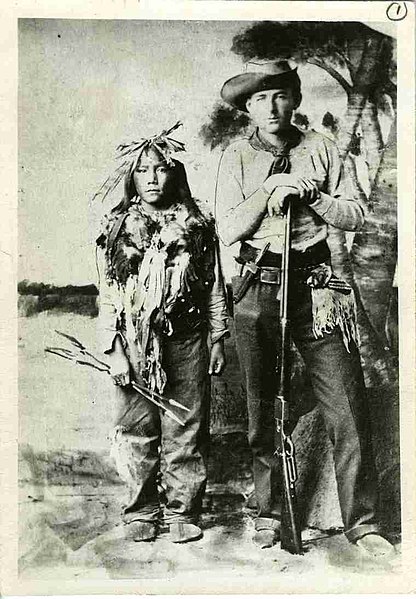Big Bear, also known as Mistahi-maskwa, was a powerful and popular Cree chief who played many pivotal roles in Canadian history. He was appointed to chief of his band at the age of 40 upon the death of his father, Black Powder, under his father's harmonious and inclusive rule which directly impacted his own leadership. Big Bear is most notable for his involvement in Treaty 6 and the 1885 North-West Rebellion; he was one of the few chief leaders who objected to the signing of the treaty with the Canadian government. He felt that signing the treaty would ultimately have devastating effects on his nation as well as other Indigenous nations. This included losing the free nomadic lifestyle that his nation and others were accustomed to. Big Bear also took part in one of the last major battles between the Cree and the Blackfoot nations. He was one of the leaders to lead his people in the last, largest battle on the Canadian Plains.
Chief Mistahi-maskwa, 1885
Big Bear trading at Fort Pitt in 1884 (from left to right) Four Sky Thunder, Sky Bird, Matoose, Napasis, Big Bear, Angus McKay, Otto Dufresne, Louis Goulet, Stanley Simpson, Mr. Rowley, Alex McDonald, Captain R. B. Sletch, Mr. Edmund, and Henry Dufrain.
A letter from General Middleton to Big Bear, urging him to surrender
Survivor of the Frog Lake Massacre William Bleasdell Cameron with Horse Child, the 12-year-old son of Big Bear. They were photographed together in Regina in 1885 during the trial of Big Bear. Cameron testified in Big Bear's defence.
The Cree are a North American Indigenous people. They live primarily in Canada, where they form one of the country's largest First Nations.
A Cree camp, likely in Montana, photographed c. 1893
A group of Cree sun dancers, photographed c. 1893 by Frank La Roche
Nēhiyaw (Plains Cree) camp near the future site of Vermilion, Alberta, in 1871
Chippewa Cree Tribal Chairman Raymond Parker Jr. signs an agreement with the FEMA in Rocky Boy's Indian Reservation, Montana on August 17, 2010.








